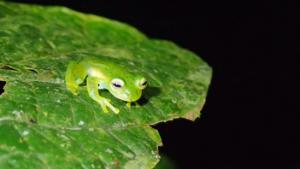Content:
After suffering mass mortality for years due to infection with the deadly Batrachochytrium dendrobatridis fungus, or chytrid, some frog populations in El Copé, Panama, now seem to be co-existing with the pathogen and stabilizing their populations.
“Our results are really promising because they lead us to conclude that the El Copé frog community is stabilizing and not drifting to extinction,” said Graziella DiRenzo, a postdoctoral researcher in ecology, evolution and marine biology (EEMB) at UC Santa Barbara. “(Extinction) is a big concern with chytrid worldwide. Before this study, we didn’t know a lot about the communities that remain after an outbreak. In some areas, it’s still a black box.”
DiRenzo, a scientist in the lab of EEMB professor Cherie Briggs, has outlined her findings in the paper “Eco-Evolutionary Rescue Promotes Host-pathogen Coexistence,” which appears in the journal Ecological Applications. She conducted her research while at Michigan State University and the University of Maryland.
The chytrid fungus, also known as Bd, began its large-scale destruction of amphibian populations in the second half of the 20th century. Around the turn of the 21st century, the mass die-offs were connected to the fungus, which causes symptoms such as skin shedding and lethargic behavior. In El Copé, Bd took out almost half of the amphibian population within a few years.
From 2010 to 2014, DiRenzo and colleagues visited the same site in El Copé to sample the frog population for Bd infection and assess the severity of the disease. The researchers’ initial assumption was that the frog population was heading toward extinction, because Bd is a very virulent, generalist pathogen, DiRenzo explained.
“Our findings did not line up with what I assumed prior to doing the research because, in our study, we found that either population seems to be relatively stable,” she said.
Among the challenges they faced during their survey was the difficulty of locating these tropical frogs, which are masters of camouflage.
“Essentially you are looking for 2- to 4-cm green frogs on green leaves or brown frogs on brown leaves, which makes it very hard to see them,” DiRenzo said. That, in turn, led them to develop a new model that could statistically correct for frogs that were present during their surveys but that they missed because the frogs were hard to detect.
The results of the researchers’ repeated data collection and statistical modeling led to their finding that while some frog species succumbed to the disease, others persisted. The researchers attribute this host-pathogen coexistence to “eco-evolutionary rescue.” This occurs when either ecological and/or evolutionary mechanisms allow for the persistence of the host and pathogen. Evolutionary mechanisms, for example, include amphibians’ immune adaption; among ecological factors are the reduced density and richness of frog species in El Copé — fewer frogs means fewer opportunities for infection.
Additionally, according to the paper, if some amphibian species (such as Atepolus varius) were “primary transmitters” of infection — able to harbor and spread large numbers of chytrid zoospores — then the extirpation of these species contributed to the decline of transmission rates in the community. Out of the 74 amphibian species noted in El Copé prior to Bd arrival, approximately 32 remain, a drastic change in the composition of the amphibian community in the area.
It’s too early to tell whether the stabilization of frog species in El Copé despite the ongoing presence of chytrid fungus will continue in the long-term, DiRenzo noted. Additional stressors such as climate change, habitat loss, pollution and invasive species present challenges to amphibian communities already struggling with Bd.
“Approximately one-third of the world’s 7,000 amphibian species are at risk of extinction,” said DiRenzo, who is now studying how Bd interacts with other pathogens that affect amphibians and how the order of pathogen infection affects outcome. “Our results provide a glimpse of hope for amphibian populations persisting in the face of major threats, but it does not mean that either amphibian populations will rebound to the abundance they were prior to the threat, or that the ecosystem structure has not been compromised.”
Contact Info:
Sonia Fernandez
(805) 893-4765
sonia(dot)fernandez(at)ucsb(dot)edu
Graziella DiRenzo
grace(dot)direnzo(at)gmail(dot)com


